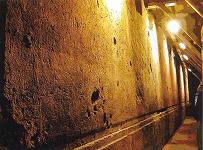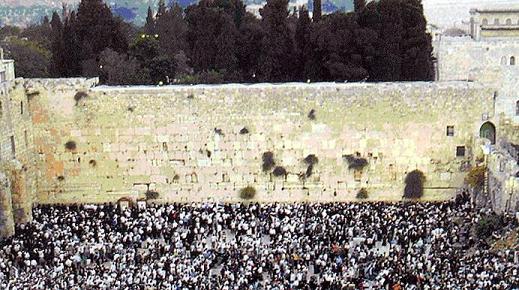WHO BUILT THE WAILING WALL – NOT HEROD!
ONE of the most recognizable sights from antiquity is the wall surrounding the Temple Mount (Haram) in Jerusalem, part of which is known as the Western or Wailing Wall, the most sacred site of Jews.
One of the great truisms of antiquity is that this wall was built by Herod and unlike many things that are taken for granted from the past, this contention remains unanimous, until now!!!!
The wall is a massive and imposing sight 2,000 years supposedly after it was built. If one stands today on the Mount of Olives and looks out over Jerusalem one cannot be but impressed by its size and grandeur. It is IMPOSSIBLE to ignore. And yet ……………
The only eye-witness account of Jerusalem at the time of Jesus comes from that most controversial of historians Josephus who graphically describes the City and the Temple before and after its destruction by the Romans.
Surely Josephus mentions that astounding wall with its massive stones.
But such a description is nowhere to be found.
THE TEMPLE
‘JOSEPHUS War of the Jews:
Book 7 – Chapter I
INTRODUCTION
HOW THE ENTIRE CITY OF JERUSALEM WAS DEMOLISHED, EXCEPTING THREE TOWERS; AND HOW TITUS COMMENDED HIS SOLDIERS IN A SPEECH MADE TO THEM, AND DISTRIBUTED REWARDS TO THEM AND THEN DISMISSED MANY OF THEM.’
NOW as soon as the army had no more people to slay or to plunder, because there remained none to be the objects of their fury,(for they would not have spared any, had there remained any other work to be done,) Caesar gave orders that they should now demolish the entire city and temple, but should leave as many of thetowers standing as were of the greatest eminency; that is, Phasaelus, and Hippicus, and Mariamne; and so much of the wall as enclosed the city on the west side. This wall was spared, in order to afford a camp for such as were to lie in garrison, as were the towers also spared, in order to demonstrate to posterity what kind of city it was, and how well fortified, which the Roman valor had subdued; but for all the rest of the wall, it was so thoroughly laid even with the ground by those that dug it up to the foundation, that there was left nothing to make those that came thither believe it had ever been inhabited. This was the end which Jerusalem came to by the madness of those that were for innovations; a city otherwise of great magnificence, and of mighty fame among all mankind.
The Wailing Wall
When Jerusalem was totally destroyed and the Temple gone, surely the wall which is now massive and imposing must have stood out like a sore thumb, the veritable “elephant in the room”. No, there is not one single word about what must have been the only major structure standing in all of Jerusalem. After all if it had been built by Herod, it MUST have been there standing out in all its massiveness. Nor can this be the sin of omission. Josephus does mention that one wall is left standing, the one that enclosed the CITY on the West side. Nothing about a massive wall surrounding the Temple Mount.
Let us skip 500 plus years and look at one of the most famous maps from Antiquity, the Madaba Map which shows Jerusalem in all its splendor in the middle of the sixth century AD.
Surely Herod’s massive wall appears on the map.
The great expert on the Jerusalem portion of the map Yoram Tzafrir states:
“The disappearance of the Temple Mount from the city’s topography probably occurred in the latter part of the fourth century. The Bordeaux pilgrim visited the area in 333 and described the monuments built on and around it”.
The problem is that the pilgrim did not describe the massive walls that should have been  seen surrounding the Temple Mount. He did not.
seen surrounding the Temple Mount. He did not.
Nor in fact did anyone else. From the time of Josephus account until the making of the Madaba Map there is not one account of seeing one of the most imposing walls in all of antiquity.
Until 558 the great Roman historian, Procopius, writes about the Emperor Justinian just a little later than the construction of the Madaba Map. Here is what he says.
“Such were the works of the Emperor Justinian in Cilicia. And in Jerusalem he dedicated to the Mother of God a shrine with which no other can be compared. This is called by the natives the “New Church”; and I shall explain of what sort it is, first making this observation, that this city is for the most part set upon hills; however these hills have no soil upon them, but stand with rough and very steep sides, causing the streets to run straight up and down like ladders.
All the other buildings of the city chance to lie in one group, part of them built upon a hill and part upon the lower level where the earth spreads out flat; but this shrine alone forms an exception. For the Emperor Justinian gave orders that it be built on the highest of the hills, specifying what the length and breadth of the building should be, as well as the other details.
However, the hill did not satisfy the requirements of the project, according to the Emperor’s specifications, but a fourth part of the church, facing the south and the east, was left unsupported, that part in which the priests are wont to perform the rites. Consequently those in charge of this work hit upon the following plan. They threw the foundations out as far as the limit of the even ground, and then erected a structure which rose as high as the rock.
All the other buildings of the city chance to lie in one group, part of them built upon a hill and part upon the lower level where the earth spreads out flat; but this shrine alone forms an exception. For the Emperor Justinian gave orders that it be built on the highest of the hills, specifying what the length and breadth of the building should be, as well as the other details. However, the hill did not satisfy the requirements of the project, according to the Emperor’s specifications, but a fourth part of the church, facing the south and the east, was left unsupported, that part in which the priests are wont to perform the rites. Consequently those in charge of this work hit upon the following plan. They threw the foundations out as far as the limit of the even ground, and then erected a structure which rose as high as the rock. And when they had raised this up level with the rock they set vaults upon the supporting walls, and joined this substructure to the other foundation of the church. Thus the church is partly based upon living rock, and partly carried in the air by a great extension artificially added to the hill by the Emperor’s power.
The Wailing wall
 The stones of this substructure are not of a size such as we are acquainted with, for the builders of this work, in struggling against the nature of the terrain and labouring to attain a height to match the rocky elevation, had to abandon all familiar methods and resort to practices which were strange and altogether unknown. So they cut out blocks of unusual size from the hills which rise to the sky in the region before the city, and after dressing them carefully they brought them to the site in the following manner. They built wagons to match the size of the stones, placed a single block on each of them, and had each wagon with its stone drawn by forty oxen which had been selected by the Emperor for their strength. But since it was impossible for the roads leading to the city to accommodate these wagons, they cut into the hills for a very great distance, and made them passable for the wagons as they came along there, and thus they completed the length of the church in accordance with the Emperor’s wish. However, when they made the width in due proportion, they found themselves quite unable to set a roof upon the building. So they searched through all the woods and forests and every place where they had heard that very tall trees grew,and found a certain dense forest which produced cedars of extraordinary height, and by means of these they put the roof upon the church, making its height in due proportion to the width and length of the building.
The stones of this substructure are not of a size such as we are acquainted with, for the builders of this work, in struggling against the nature of the terrain and labouring to attain a height to match the rocky elevation, had to abandon all familiar methods and resort to practices which were strange and altogether unknown. So they cut out blocks of unusual size from the hills which rise to the sky in the region before the city, and after dressing them carefully they brought them to the site in the following manner. They built wagons to match the size of the stones, placed a single block on each of them, and had each wagon with its stone drawn by forty oxen which had been selected by the Emperor for their strength. But since it was impossible for the roads leading to the city to accommodate these wagons, they cut into the hills for a very great distance, and made them passable for the wagons as they came along there, and thus they completed the length of the church in accordance with the Emperor’s wish. However, when they made the width in due proportion, they found themselves quite unable to set a roof upon the building. So they searched through all the woods and forests and every place where they had heard that very tall trees grew,and found a certain dense forest which produced cedars of extraordinary height, and by means of these they put the roof upon the church, making its height in due proportion to the width and length of the building.
I. If there was a massive wall in existence at the time Justinian did his building why would Procopius state:
“The stones of this substructure are not of a size such as we are acquainted with”
2. If the so-called Herodian walls were there in ruins why would they need to build carts and bring new stones from the hills surrounding Jerusalem.
Mosaic
 No my friends, all the evidence leads one to suppose that the famous Herodian Wall surrounding the Temple Mount were in fact built by Justinian some five hundred years later and that puts the final nail in the coffin of the theory that Solomon’s temple and Herod’s Temple were ever on the Temple Mount. They were built in the most logical place of all, over the Gihon Spring in the City of David, just 600 feet down the road.
No my friends, all the evidence leads one to suppose that the famous Herodian Wall surrounding the Temple Mount were in fact built by Justinian some five hundred years later and that puts the final nail in the coffin of the theory that Solomon’s temple and Herod’s Temple were ever on the Temple Mount. They were built in the most logical place of all, over the Gihon Spring in the City of David, just 600 feet down the road.


